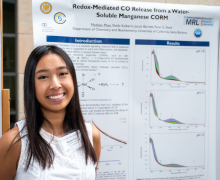
Major:
University:
Mentor(s):
Faculty Sponsor(s):
Faculty Sponsor's Department(s):
Project Title:
Project Description:
Carbon monoxide (CO) is a versatile signaling molecule that is produced endogenously and is suggested to exert anti-inflammatory, anti-apoptotic, and anti-proliferative effects. Carbon monoxide releasing molecules (CORMs), such as [fac-Mn(CO)3(Br)(bpCO2)]2-, (A, bpCO22- = 2,2’-bipyridine-4,4’-dicarboxylate dianion), have potential to deliver therapeutic levels of CO to tumors to serve as an anti-cancer strategy. Because hypoxic tumors have significantly higher hydrogen peroxide (H2O2) concentrations compared to normal tissues, there are implications for physiological CO delivery by using endogenous H2O2 to trigger CO release from CORMs, such as A. However, the dynamics of H2O2 reactions with CORMs are not well understood. To assess the viability of using this class of reactions with CORMs in cancer therapy, we have undertaken a quantitative kinetics study of the H2O2 oxidation of the water-soluble complex, A. Previous studies in our group demonstrated that about 2.5 equivalents of CO were released upon H2O2 oxidation of A via pH-dependent kinetics that are first-order in both [A] and in [H2O2]. At higher pH’s, there is a greater presence of the more nucleophilic and reactive conjugate base of H2O2, the hydroperoxy anion, HOO-. The present experimental studies employ stopped flow kinetics to evaluate this reaction’s mechanisms and key intermediates under more basic pH’s to investigate the role of HOO-. Understanding these pathways is critical in using CORMs to apply the therapeutic potential of CO in several disease states featuring physiological H2O2.
